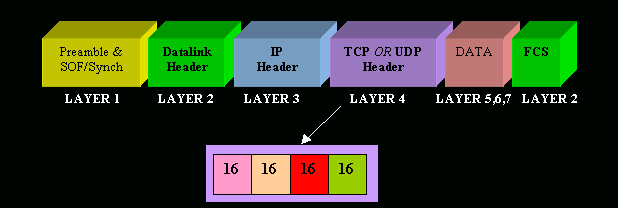UDP Protocol - Header
This article covers the UDP protocol. We examine the structure of the UDP header, the protocols that use UDP as a transport plus a lot more.
Some common protocols which use UDP are: DNS, TFTP, ARP, RARP and SNMP.
When people refer to "TCP/IP" remember that they are talking about a suite of protocols, and not just one (as most people think). TCP/IP is NOT one protocol. Please see the Protocols section for more information.
The User Datagram Protocol (UDP) is defined by IETF RFC768.
UDP - User Datagram Protocol
The second protocol used at the Transport layer is UDP. Application developers can use UDP in place of TCP. UDP is the scaled-down economy model and is considered a thin protocol. Like a thin person in a car, a thin protocol doesn't take up a lot of room - or in this case, much bandwidth on a network.
protocol used at the Transport layer is UDP. Application developers can use UDP in place of TCP. UDP is the scaled-down economy model and is considered a thin protocol. Like a thin person in a car, a thin protocol doesn't take up a lot of room - or in this case, much bandwidth on a network.
UDP as mentioned dosen't offer all the bells and whistles of TCP, but it does a fabulous job of transporting information that doesn't require reliable delivery and it does so using far fewer network resources.
Unreliable Transport
UDP is considered to be an unreliable transport protocol. When UDP sends segments over a network, it just sends them and forgets about them. It doesn't follow through, check on them, or even allow for an acknowledgment of safe arrival, in other words .... complete abandonment! This does not mean that UDP is ineffective, only that it doesn't handle issues of reliability.
The picture below shows us the UDP header within a data packet. This is to show you the different fields a UDP header contains:


Connection-less Oriented
For those who read our TCP section, you would know it is a connection oriented protocol, but UDP isn't. This is because UDP doesn't create a virtual circuit (establish a connection before data transfer), nor does it contact the destination before delivering information to it. No 3-way handshake or anything like that here!
Since UDP assumes that the application will use its own reliability method, it doesn't use any, which obviously makes things transfer faster.
Less Overhead
The very low overhead, compared to TCP, is a result of the lack of windowing or acknowledgments. This certainly speeds things up but you get an unreliable (in comparison to TCP) service.
 |
Some common protocols which use UDP are: DNS, TFTP, ARP, RARP and SNMP. When people refer to "TCP/IP" remember that they are talking about a suite of protocols, and not just one (as most people think). TCP/IP is NOT one protocol. Please see the Protocols section for more information. The User Datagram Protocol (UDP) is defined by IETF RFC768 |
|
UDP - User Datagram Protocol The second protocol used at the Transport layer is UDP. Application developers can use UDP in place of TCP. UDP is the scaled-down economy model and is considered a thin protocol. Like a thin person in a car, a thin protocol doesn't take up a lot of room - or in this case, much bandwidth on a network. UDP as mentioned dosen't offer all the bells and whistles of TCP, but it does a fabulous job of transporting information that doesn't require reliable delivery and it does so using far fewer network resources. Unreliable Transport UDP is considered to be an unreliable transport protocol. When UDP sends segments over a network, it just sends them and forgets about them. It doesn't follow through, check on them, or even allow for an acknowledgment of safe arrival, in other words .... complete abandonment! This does not mean that UDP is ineffective, only that it doesn't handle issues of reliability. The picture below shows us the UDP header within a data packet. This is to show you the different fields a UDP header contains:
Connection-less Oriented For those who read about TCP, you would know it is a connection oriented protocol, but UDP isn't. This is because UDP doesn't create a virtual circuit (establish a connection before data transfer), nor does it contact the destination before delivering information to it. No 3-way handshake or anything like that here! Since UDP assumes that the application will use its own reliability method, it doesn't use any, which obviously makes things transfer faster. Less Overhead The very low overhead, compared to TCP, is a result of the lack of windowing or acknowledgments. This certainly speeds things up but you get an unreliable (in comparison to TCP) service. There really isn't much more to write about UDP so I'll finish here. |
|
Your IP address:
18.218.72.253
Wi-Fi Key Generator
Follow Firewall.cx
Cisco Password Crack
Decrypt Cisco Type-7 Passwords on the fly!















